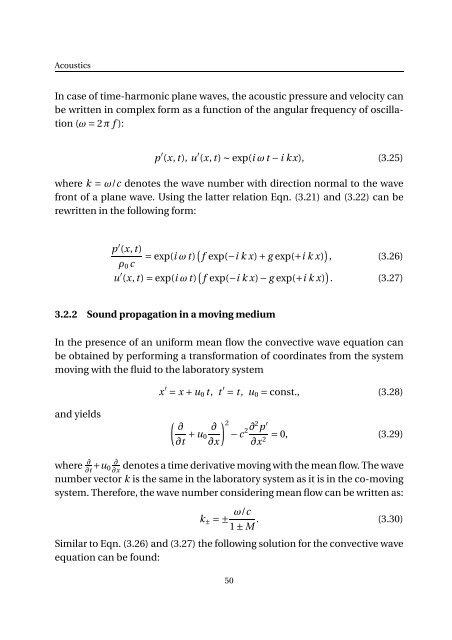Impact of fuel supply impedance and fuel staging on gas turbine ...
Impact of fuel supply impedance and fuel staging on gas turbine ...
Impact of fuel supply impedance and fuel staging on gas turbine ...
Create successful ePaper yourself
Turn your PDF publications into a flip-book with our unique Google optimized e-Paper software.
Acoustics<br />
In case <str<strong>on</strong>g>of</str<strong>on</strong>g> time-harm<strong>on</strong>ic plane waves, the acoustic pressure <str<strong>on</strong>g>and</str<strong>on</strong>g> velocity can<br />
be written in complex form as a functi<strong>on</strong> <str<strong>on</strong>g>of</str<strong>on</strong>g> the angular frequency <str<strong>on</strong>g>of</str<strong>on</strong>g> oscillati<strong>on</strong><br />
(ω=2π f ):<br />
p ′ (x, t ), u ′ (x, t )∼exp(i ω t− i kx), (3.25)<br />
where k = ω/c denotes the wave number with directi<strong>on</strong> normal to the wave<br />
fr<strong>on</strong>t <str<strong>on</strong>g>of</str<strong>on</strong>g> a plane wave. Using the latter relati<strong>on</strong> Eqn. (3.21) <str<strong>on</strong>g>and</str<strong>on</strong>g> (3.22) can be<br />
rewritten in the following form:<br />
p ′ (x, t )<br />
= exp(i ω t ) ( f exp(−i k x)+ g exp(+i k x) ) , (3.26)<br />
ρ 0 c<br />
u ′ (x, t )=exp(i ω t ) ( f exp(−i k x)− g exp(+i k x) ) . (3.27)<br />
3.2.2 Sound propagati<strong>on</strong> in a moving medium<br />
In the presence <str<strong>on</strong>g>of</str<strong>on</strong>g> an uniform mean flow the c<strong>on</strong>vective wave equati<strong>on</strong> can<br />
be obtained by performing a transformati<strong>on</strong> <str<strong>on</strong>g>of</str<strong>on</strong>g> coordinates from the system<br />
moving with the fluid to the laboratory system<br />
x ′ = x+ u 0 t , t ′ = t , u 0 = c<strong>on</strong>st., (3.28)<br />
<str<strong>on</strong>g>and</str<strong>on</strong>g> yields<br />
( ) ∂<br />
∂t + u ∂ 2<br />
0 − c 2∂2 p ′<br />
= 0, (3.29)<br />
∂x ∂x2 where ∂ ∂t +u 0 ∂ denotes a time derivative moving with the mean flow. The wave<br />
∂x<br />
number vector k is the same in the laboratory system as it is in the co-moving<br />
system. Therefore, the wave number c<strong>on</strong>sidering mean flow can be written as:<br />
k ± =± ω/c<br />
1± M . (3.30)<br />
Similar to Eqn. (3.26) <str<strong>on</strong>g>and</str<strong>on</strong>g> (3.27) the following soluti<strong>on</strong> for the c<strong>on</strong>vective wave<br />
equati<strong>on</strong> can be found:<br />
50
















